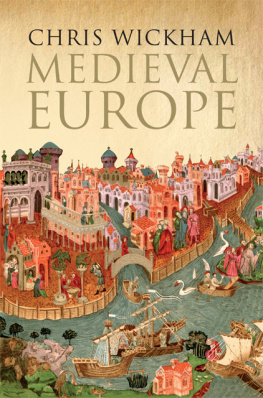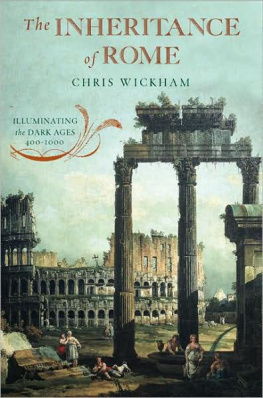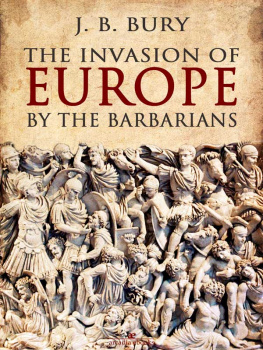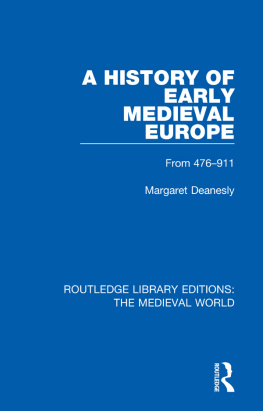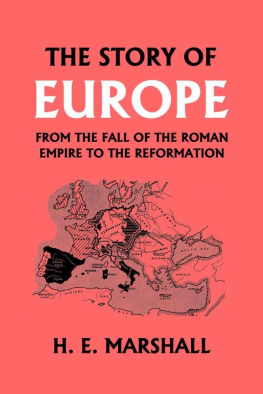MEDIEVAL EUROPE

Copyright 2016 Chris Wickham
All rights reserved. This book may not be reproduced in whole or in part, in any form (beyond that copying permitted by Sections 107 and 108 of the U.S. Copyright Law and except by reviewers for the public press) without written permission from the publishers.
For information about this and other Yale University Press publications, please contact:
U.S. Office:
Europe Office:
Typeset in Minion Pro by IDSUK (DataConnection) Ltd
Printed in Great Britain by Gomer Press Ltd, Llandysul, Ceredigion, Wales
Library of Congress Cataloging-in-Publication Data
Names: Wickham, Chris, 1950 author.
Title: Medieval Europe / Chris Wickham.
Description: New Haven : Yale University Press, 2016. | Includes bibliographical references.
LCCN 2016018675 | ISBN 9780300208344 (cloth : alkaline paper)
LCSH: EuropeHistory4761492. | Middle Ages. | Social changeEuropeHistoryTo 1500. | EuropeSocial conditionsTo 1492. | BISAC: HISTORY / Medieval. | HISTORY / Europe / General. | HISTORY / Social History.
Classification: LCC D117 .W53 2016 | DDC 940.1dc23
LC record available at https://lccn.loc.gov/2016018675
A catalogue record for this book is available from the British Library.
10 9 8 7 6 5 4 3 2 1
Contents
Illustrations and maps
Illustrations
Ivory diptych for Manlius Boethius, 487. Museo Civico Cristiano, Brescia, Italy/Bridgeman Images.
Saint Jean baptistery, Poitiers, sixth century. Nick Hanna/Alamy Stock Photo.
Votive crown of Recceswinth, 660s. Prisma Archivo/Alamy Stock Photo.
Hagia Sophia, Constantinople (Istanbul), 530s. Photo by Leslie Brubaker.
Birmingham Quran, c. 640s650s, fols 2r and 1v. University of Birmingham.
Reception hall, Madinat al-Zahra, Crdoba, 950s.
Palace chapel, Aachen cathedral, c. 800.
).
Lindisfarne Gospels, Gospel of Luke, early eighth century. The British Library (Cotton MS Nero D.IV, f.139).
Stave church, Heddal, Norway, thirteenth century.
Bronze doors, Gniezno cathedral, late twelfth century, depicting the death scene of the life of Adalbert of Prague. Jan Wlodarczyk/Alamy Stock Photo.
Rocca San Silvestro, Tuscany, thirteenth century. Ventodiluna.
Apse mosaic of San Clemente, Rome, c. 1118. imageBROKER/Alamy Stock Photo.
Pisa cathedral, late eleventh and early twelfth century. M&M Photo.
Gravensteen castle, Ghent, late twelfth century. Alpineguide/Alamy Stock Photo.
The Mercure Shakespeare Hotel, Stratford, thirteenthsixteenth centuries. Mark Beton/England/Alamy Stock Photo.
Notre Dame cathedral, le de la Cit, Paris. Peter Bull.
Pipe roll, late twelfth century, 10 Hen II, 116364. The National Archives, London.
Statues of Ekkehard of Meissen and Uta of Ballenstadt, Naumburg cathedral, mid-thirteenth century. VPC Travel Photo/Alamy Stock Photo.
The Dream of Innocent III, fresco by Giotto di Bondone, church of San Francesco, Assisi, 1290s. Bridgeman Images.
Northern (Istanbul) gate, city walls of Nicaea (znik, Turkey), Roman to early thirteenth century. EBA.
The Anastasis, Kariye Camii (Chora monastery), Constantinople (Istanbul), c. 1320. QC.
.
.
St Anne teaching the Virgin to read, French manuscript illumination, 1430s. The J. Paul Getty Museum, Los Angeles, Ms. 5, fol. 45v. Digital image courtesy of the Gettys Open Content Program.
Effects of good government in the city, by Ambrogio Lorenzetti, Palazzo Pubblico, Siena, 133839. Fonazione Musei Senesi.
Egil Skallagrimsson, illustration probably by Hjalti orsteinsson from an Icelandic manuscript, seventeenth century, AM 426, f. 2v. Photo by Jhanna lafsdttir, image courtesy of the rni Magnsson Institute for Icelandic Studies.
.
Charles bridge, Prague, late fourteenth century. Book Travel Prague.
Patio de las Doncellas, Alcazar, Seville, 1360s. funkyfood London Paul Williams/Alamy Stock Photo.
Enea Silvio Piccolomini sets out for the Council of Basel, by Pinturicchio, Siena cathedral, 1500s. Piccolomini Library, Siena Cathedral, Italy/F. Lensini, Siena/Bridgeman Images.
Piazza Pio II, Pienza, Tuscany, 145962. Siephoto/Masterfile.
Maps
Europe in 550.
Western Europe in 850.
Eastern Europe in 850.
Western Europe in 1150.
Eastern Europe in 1150.
Western Europe in 1500.
Eastern Europe in 1500.
Acknowledgements
My first thanks go to Heather McCallum, who suggested that I write this book and finally persuaded me; she also critiqued its drafts and was a reality check throughout. Leslie Brubaker read the whole book and made it clear what changes I could not avoid making; so did two very supportive Yale readers. Many other friends read parts of the book: Pat Geary and Mayke de Jong read . I could not have done this without their (often highly critical) support, especially when I moved into parts of the middle ages I knew relatively little about. Several other people helped me with advice and references and to find books: Peter Coss, Lorena Fierro Daz, Marek Jankowiak, Tom Lambert, Isabella Lazzarini, Conrad Leyser, Sophie Marnette, Giedre Mickunaite, Maureen Miller, Natalia Nowakowska, Helmut Reimitz, John Sabapathy, Mark Whittow, Emily Winkler, are only some of them. I cannot even list the many people who saved me from errors in casual conversation, not knowing that I was taking mental notes; but all the speakers at the Monday-at-5 medieval seminar which I have run for eleven years at Oxford with Mark Whittow have contributed, in one way or another, to my ideas in this book. I have also to thank RAE2008 and REF2014 for their intellectual stimulus: they forced me to read significant books and articles on a wide variety of topics which I would not always have come across otherwise, and many of these are in the bibliography.
C.W.
January 2016

Map 1 Europe in 550.

Map 2 Western Europe in 850.

Map 3 Eastern Europe in 850.

Map 4 Western Europe in 1150.

Map 5 Eastern Europe in 1150.

Map 6 Western Europe in 1500.

Map 7 Eastern Europe in 1500.

1. Consular diptych for Manlius Boethius, 487. It was very common for late Roman aristocrats to commission commemorative ivory diptychs (pictures in two halves) such as this one, for special occasions in this case Boethius appointment as consul and prefect of Rome. On the right he holds the signal for the start of chariot racing, for these offices involved the patronage of expensive games. The consul was probably the father of the major philosopher, also called Boethius, executed for treason by Theoderic, king of Italy, in 524.
Next page
